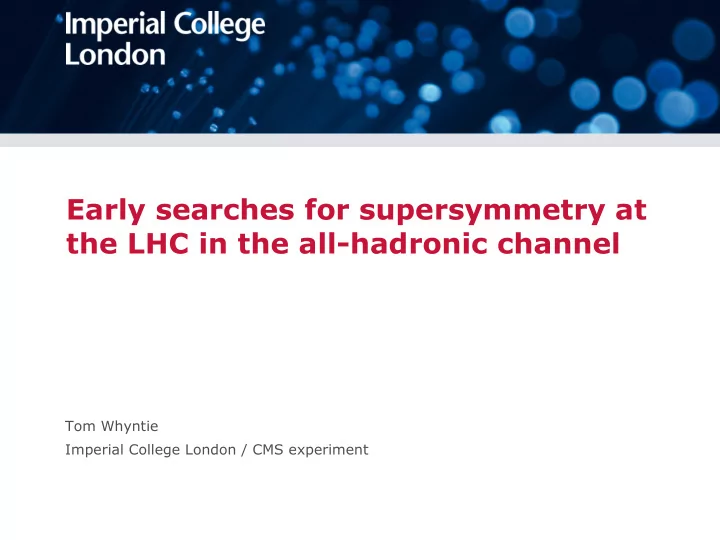

Early searches for supersymmetry at the LHC in the all-hadronic channel Tom Whyntie Imperial College London / CMS experiment
Introduction How do we look for supersymmetry at the LHC? • What are the challenges of the all-hadronic channel? How can we guard against mismeasurement? • Can we use kinematics to constrain fake missing E T ? How do we account for Standard Model backgrounds? • What data-driven tools exist to estimate real missing E T ? 25 th March 2010 Tom Whyntie, Imperial College London 2 of 11
Introduction How do we look for supersymmetry at the LHC? • What are the challenges of the all-hadronic channel? How can we guard against mismeasurement? • Can we use kinematics to constrain fake missing E T ? How do we account for Standard Model backgrounds? • What data-driven tools exist to estimate real missing E T ? 25 th March 2010 Tom Whyntie, Imperial College London 3 of 11
Supersymmetry at the LHC Supersymmetry is an extension to the Standard Model (SM) that predicts massive, undetectable superpartners to SM particles. These may be produced in LHC proton-proton collisions. Typical experimental signature: • Large missing transverse energy plus final state objects. q q q LSP q q q LSP + similar 25 th March 2010 Tom Whyntie, Imperial College London 4 of 11
The all-hadronic channel We consider events with only jets in the final state: • “Jet”: clustered energy deposits in the calorimeters from the hadronisation of partons. • Tracking information may also be used for identification and/or correction of measured jet energy. Advantage : no isolated leptons, which can indicate SM processes with real missing E T (typically featuring W � l � ) • Still leaves Z � �� , W � �� ( the � decaying hadronically ) Disadvantage : Large QCD background. Statistically unlikely detector mismeasurements, that produce fake missing E T , start to overwhelm any non-SM signal. 25 th March 2010 Tom Whyntie, Imperial College London 5 of 11
Allowing for mismeasurement QCD-like events will generally conserve transverse momentum. Mismeasurement leads to the observation of “fake” missing E T . The search described here takes the following approach: • Use only “trusted” physics objects as input to the missing E T calculations, ignoring unclustered energy and events with “anomalies”. • Use event observables that compensate for object mismeasurements. 25 th March 2010 Tom Whyntie, Imperial College London 6 of 11
The � T observable Dijets: Randall (2008) proposed � T / M(dijet) . We use � T = E j2 T / M T (dijet) : = E j2 � � � � � � � � j 1 j 2 2 2 M 2 E E 1 cos H p � Denominator: T T T T T � � � 2 � � j 2 E H H 1 Numerator: T T T � � j 1 j 2 H E E T T T � � � j 1 j 2 H E E T T T Conserved event, perfect measurement � � T = 1/2 � � Real missing E T : Small denom. � large � T � � 1 H min . H � � T T Mismeasurement: Small num. � small � T T ( N ) 2 � 2 2 H p � T T Extension to n -jets: Generalise � H T 25 th March 2010 Tom Whyntie, Imperial College London 7 of 11
The CMS experiment Solenoid: 3.8 T magnetic field. Energy measurements: • Electromagnetic calorimeter (ECAL); • Hadronic calorimeter (HCAL). Tracking: All-silicon tracker. Muon chambers outside solenoid. 25 th March 2010 Tom Whyntie, Imperial College London 8 of 11
Event selection Triggers: • High-Level Trigger (HLT) Single 110 GeV jet. Pre-selection: • Jet requirements (also defines event jet multiplicity, N ): » At least two jets with p T > 50 GeV , | � | < 3.0 , EM fraction < 0.9; » Leading jet p T > 100 GeV, | � | < 2.0 ; » Second jet p T > 100 GeV ; • Lepton veto: Reject events with isolated e or � , p T > 10 GeV ; • Photon veto: Reject events with isolated � , p T > 25 GeV ; • “Bad” jet veto: Reject events with p T > 50 GeV jets that fail | � |, EM fraction requirements. 25 th March 2010 Tom Whyntie, Imperial College London 9 of 11
Applying the kinematic cuts Additional cut made on H T > 350 GeV Final cut made on � T > 0.55 10 TeV, 100 pb -1 N = 2 N = 3,4,5,6 QCD is heavily suppressed H T of events passing selection 25 th March 2010 Tom Whyntie, Imperial College London 10 of 11
Estimating SM contributions 1) Treat the backgrounds as one, exploiting non-SM signal centrality. SM backgrounds only With LM0 signal 2) Estimate individual SM background contributions, e.g. Z � �� + jets tt + jet(s), W + jet(s), etc. Z � �� is statistics limited; Replace W � �� with use W +jets, � +jets. W � �� in data using � template. 25 th March 2010 Tom Whyntie, Imperial College London 11 of 11
Conclusions We can look for SUSY in the all-hadronic channel: • Signature: Large missing E T + final state jets. Non-SUSY backgrounds can be controlled with kinematics: • Mismeasured QCD events are the dominant SM background; • Compensating observables, e.g. � T , can suppress these. Tools exist for estimating real missing E T SM backgrounds. Thanks for listening – any questions? 25 th March 2010 Tom Whyntie, Imperial College London 12 of 11
Recommend
More recommend